Two charges, each equal to q, are kept at x=−a and x=a on the x-axis. A particle of mass m and charge is placed at the origin. If charge is given a small displacement (<<a) along the-axis, the net force acting on the particle is
1.
2. −
3. 1/
4. −1/
Two identical charged spheres suspended from a common point by two massless strings of length l are initially a distance d(d<<l) apart because of their mutual repulsion. The change begins to leak from both the spheres at a constant rate. As a result the charges approach each other with a velocity v. Then as a function of distance x between them
1.
2.
3.
4.
Three infinitely long charge sheets are placed as shown in figure. The electric field at point P is
1.
2. −
3.
4. −
Three concentric metallic spherical shells of radiiR, 2R, 3R, are given charges ,,, respectively. It is found that the surface charge densities on the outer surfaces of the shells are equal. Then, the ratio of the charges given to the shells, ::, is
1. 1: 2: 3
2. 1: 3: 5
3. 1: 4: 9
4. 1: 8: 18
Consider a uniform spherical charge distribution of radius centred at the origin O. In this distribution, a spherical cavity of radius , centred at P with distance OP = a = − (see figure) is made. If the electric field inside the cavity at position is , then the correct statement(s) is(are)
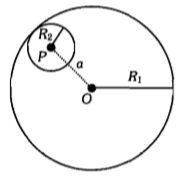
1. is uniform, its magnitude is independent of but its direction depends on
2. is uniform, its magnitude independs of and its direction depends on
3. is uniform, its magnitude is independent of a but its direction depends on
4. is uniform, and both its magnitude and direction depends on
Charge q is uniformly distributed over a thin half ring of radius R. The electric field at the centre of the ring is
1.
2.
3.
4.
Two concentric conducting thin spherical shells A, and B having radii and (>) are charged to and −(∣∣>∣∣). The electrical field along a line, (passing through the centre) is
| 1. |  |
2. |  |
| 3. |  |
4. |  |
The spatial distribution of the electric field due to charges(A,B) is shown in figure. Which one of the following statements is correct

1. A is +ve andB -ve and ∣A∣>∣B∣
2. A is -ve and B+ve;∣A∣=∣B∣
3. Both are + ve but A>B
4. Both are -ve but A>B
Consider an electric field , where is a constant. The flux through the bounded region (as shown in the figure) due to the field is - 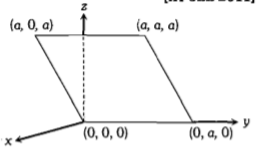
1.
2.
3.
4.
A charged ball B hangs from a silk thread S, which makes an angle θ with a large charged conducting sheet P as shown in the figure. The surface charge density of the sheet is proportional to

1. cosθ
2. cotθ
3. sinθ
4. tanθ
Three charges −+ and − s are placed as shown in the figure. The x -component of the force on − is proportional to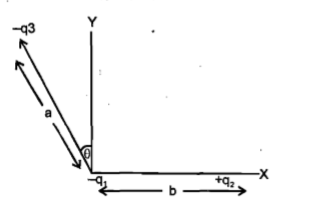
1.
2.
3.
4.
Figure shows tracks of three charged particles in uniform electro static field. If , and are the specific charges, that is charge per unit mass of the particles respectively, then
1. >>
2. <<
3. >>
4. > >
Four particles, each having charge q, are placed at four vertices of a regular pentagon. The distance of each comer from the centre is a . The electric field at the centre O of the pentagon is
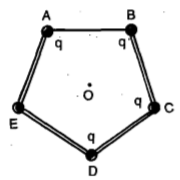
1. along EO
2. along OE
3. along EO
4. along OE
The electric force between two short electric dipoles separated by a distance varies as:
1.
2.
3.
4.
A thin semi-circular ring of radius r has a positive charge q distributed uniformly over it. The net field E at the centre O is

1.
2.
3.
4.
A ring of charge with radius0.5m has 0.02 m gap. If the ring carries a charge of +1C, the field at the centre is

1. 2.31×10 N/C
2. 2.31×10 N/C
3. 1.6× 10 N/C
4. 1.6×10 N/C
Four charges equal to −Q are placed at the four corners of a square and a chargeq is at its centre. If the system is in equilibrium the value of q is
1.
2.
3.
4.
Point charge \(q\) moves from point \(P\) to point \(S\) along the path \(PQRS\) (figure) in a uniform electric field \(E\) pointing parallel to the positive direction of the \(x\text-\)axis. The coordinates of the points \(P,Q, R\) and \(S\) are \((a, b, 0), (2a, 0, 0), (a, -b,0)\) and \((0, 0, 0)\) respectively. The work done by the field in the above process is given by expression: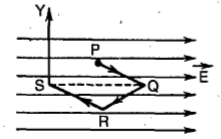
1. \(qEa\)
2. \(-qEa\)
3. \(-qEa\sqrt{2}\)
4. \(qE\sqrt{2a^2+b^2}\)
A metallic sphere is placed in a uniform electric field. The lines of force follow the path
(s) shown in the figure as
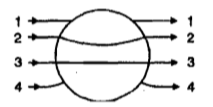
1. 1
2. 2
3. 3
4. 4